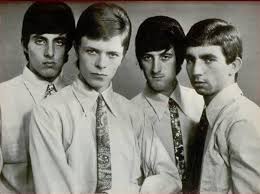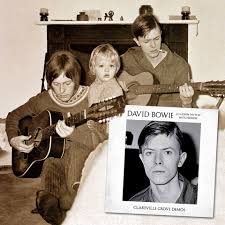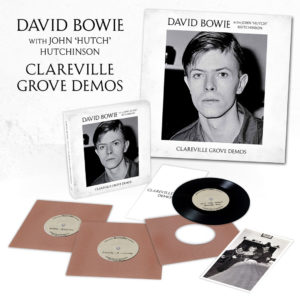Album Review: David Bowie – Clareville Grove Demos (Parlophone)
This collection of six songs recorded as demos in early 1969 finds the young David Bowie still searching for a musical voice that will connect with an audience. That audience was just a few months away.
Not an album, or an EP, per se, this package includes three seven inch 45s, each containing two songs, all of which were recorded in January of 1969 at a small flat in London by Bowie along with John “Hutch” Hutchinson.
By this time, Bowie had spent five years trying on different musical personas in an effort to become a successful musician, or artist, or pop star.
 His early bands from 1964 and 65 with names like The King Bees and The Manish Boys aimed to emulate the blues based rock of The Rolling Stones and The Yardbirds.
His early bands from 1964 and 65 with names like The King Bees and The Manish Boys aimed to emulate the blues based rock of The Rolling Stones and The Yardbirds.
By 1967, Bowie had changed tact completely, taking on a sound that was a mix of traditional English music hall and then-current psychedelia…think Anthony Newley meets Syd Barrett.
The resulting album, released on June 1, 1967 (the same day as Sgt Pepper), was a flop.
1968 found Bowie taking dance classes with Lindsay Kemp and toying with avant-garde theatre and mime…Bowie as Marcel Marceau.
 By the end of the year he had teamed up with Hermione Farthingale and John Hutchinson to form Feathers, a folk-based trio…Bowie as part of Peter, Paul & Mary.
By the end of the year he had teamed up with Hermione Farthingale and John Hutchinson to form Feathers, a folk-based trio…Bowie as part of Peter, Paul & Mary.
Which leads us to these recordings.
By 1969, Hermoine had scooted off to Norway to appear in a film, leaving poor David broken-hearted (see Letter To Hermoine)
Feathers now became David Bowie and Hutch and so, Peter, Paul & Mary where now Simon & Garfunkel.
 Desperate for a recording contract the two friends recorded these six tracks in their flat using a Revox reel to reel tape recorder. Two of the tracks, Space Oddity and An Occasional Dream have been previously released, but this is the first official airing for the other four.
Desperate for a recording contract the two friends recorded these six tracks in their flat using a Revox reel to reel tape recorder. Two of the tracks, Space Oddity and An Occasional Dream have been previously released, but this is the first official airing for the other four.
Here’s a track-by-track rundown:
Disc 1 Side 1: Space Oddity – We all know it was bound to be a hit later in the year, but in January Bowie was still working it out. This is very much a duet, with Hutch taking the lead vocal during the first verse. Instrumentation is acoustic guitars and a “Sylophone”, a kind of pocket electronic organ. Bowie’s high harmonies are impressive…Bowie as Garfunkel…and this is an excellent version.
Disc 1 Side 2: Lover To The Dawn – Again, Hutch takes the lead early on with Bowie on high harmonies. Fans will recognise the tune as that of Cygnet Committee, which would appear on Bowie’s next album with very different lyrics.
Disc 2 Side 1 : Ching-A-Ling – This whimsical little ditty is one of my faves, thanks in part to the “Doo-dah-doo” chorus. Bowie takes on most of the vocal duties here…I love hearing him sing my name…sort of.
Disc 2 Side 2: An Occasional Dream – Another tune that made it on to the “Space Oddity” album, as it would be come to be known. This version features nice counterpoint vocals between Bowie and Hutch and some rather poetic lyrics inspired by the dear departed Hermione.
Disc 3 Side 1: Let Me Sleep Beside You – A song that Bowie had around and first recorded in 1967. To these ears it’s the least interesting of the bunch, though Bowie must have liked it as he revisited it as late as 2000 when he recorded it one last time…you can hear that on the 2014 compilation album, Nothing Has Changed.
Disc 3 Side 2: Life Is A Circus – This is the only non-Bowie composition in the package. It was written by a guy named Roger Bunn , a member of a band called Djinn, who worked with producer Tony Visconti. Visconti, in turn, passed it on to Bowie who gave this a very Simon & Garfunkel treatment, indeed.
So, that’s it. I should point out that the recording quality of all tracks is very good and these are all fully-formed recordings, rather than fragments. As such, they are very listenable and give a good representation of where David Bowie was at, musically at the beginning of 1969. By the end of the year, things would be very different.
Marty Duda